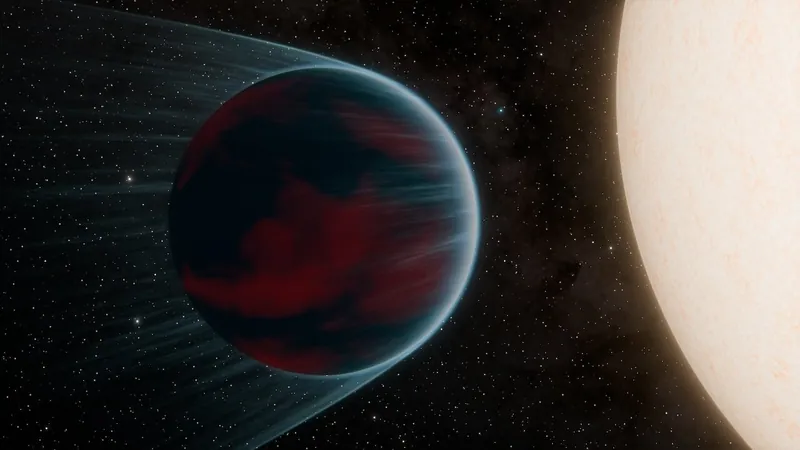
Astronomers Unveil a "Hot Neptune" in a Gripping Orbit – What It Means for Planetary Science!
2024-11-26
Author: Michael
A Rare Discovery
In an exciting breakthrough, astronomers have identified a rare Neptune-sized planet known as TOI-3261 b, which makes a blistering orbit around its host star. This discovery marks only the fourth such planet ever recorded, and it holds the potential to significantly enhance our understanding of how planets like these are formed.
Methodology and Observations
An international team of scientists utilized NASA's Transiting Exoplanet Survey Satellite (TESS) to discover this exoplanet and later conducted additional observations with ground telescopes across Australia, Chile, and South Africa. Remarkably, TOI-3261 b has been categorized as residing in the "hot Neptune desert," a term describing the alarming scarcity of this type of planet, similar to an uninhabited landscape.
Research and Publication
The research was led by astronomer Emma Nabbie from the University of Southern Queensland, who published a revealing paper titled "Surviving in the Hot Neptune Desert: The Discovery of the Ultrahot Neptune TOI-3261 b" in The Astronomical Journal in August 2024.
Unique Characteristics of TOI-3261 b
TOI-3261 b mirrors the size and composition of our own Neptune but orbits its star at a dangerously close distance, completing a full revolution in merely 21 hours. This unique attribute places it alongside a select group of ultra-short-period hot Neptunes, with only three other members known to have their masses accurately measured.
The Implications for Planetary Science
A smashing lead-in to future discoveries, TOI-3261 b presents an ideal subject for testing new computer models regarding planet formation. One of the main reasons these hot Neptunes are so scarce is that it can be challenging for them to maintain a thick gaseous atmosphere in close proximity to their star.
Formation and Mass Loss Mechanisms
Stars, with their immense size, exert a considerable gravitational pull on surrounding objects, often stripping away the gas layers surrounding nearby planets. Additionally, the vast energy emitted by stars contributes to the erosion of those gaseous layers.
This forces astronomers to theorize that TOI-3261 b could have originated as a larger Jupiter-like planet, which subsequently shed a considerable portion of its mass as it approached its star.
By simulating different formative scenarios, scientists concluded that the star-planet system is approximately 6.5 billion years old, indicating that TOI-3261 b once started as a gas giant. Its mass loss likely occurred through two main mechanisms: photoevaporation, where stellar energy dissipates gas particles, and tidal stripping, where gravitational forces remove gas layers from the planet. Interestingly, TOI-3261 b might have initially formed at a greater distance from its star, where the effects of these phenomena were less potent, thus enabling it to preserve some of its atmosphere.
The Atmospheric Mystery
The planet's remaining atmosphere, a key feature of its allure, is set to become a primary focus for further study—potentially providing invaluable insights into the history of this intriguing inhabitant of the "hot Neptune desert."
Density and Composition
Notably, TOI-3261 b is about twice as dense as Neptune, indicating that lighter atmospheric components have been stripped away over time, leaving only the heavier elements behind. While it is still a mystery what specific elements remain, researchers believe that the planet's atmosphere was once diverse.
Future Research with James Webb Space Telescope
Astrobiologists are optimistic that the solution to this enigma may come through infrared observations, possibly employing NASA's James Webb Space Telescope. This advanced tool is perfectly suited to detect the unique chemical signatures of different molecules in TOI-3261 b’s atmosphere. Such findings could help astronomers not only decode the past of this hot giant but also explore the fundamental processes governing the formation of all similar exoplanets.
Did You Know?
The journey into the realm of ultra-short-period hot Neptunes began with the discovery of LTT-9779 b in 2020. Since then, TESS has identified two more members of this exclusive group—TOI-849 b and TOI-332 b—whose masses have also been accurately measured. Excitingly, these planets are slated for infrared exploration using the James Webb Space Telescope, which could significantly enhance our comprehension of their atmospheres in the near future.
Stay tuned for what could be revolutionary developments in our understanding of exoplanetary science!









 Brasil (PT)
Brasil (PT)
 Canada (EN)
Canada (EN)
 Chile (ES)
Chile (ES)
 España (ES)
España (ES)
 France (FR)
France (FR)
 Hong Kong (EN)
Hong Kong (EN)
 Italia (IT)
Italia (IT)
 日本 (JA)
日本 (JA)
 Magyarország (HU)
Magyarország (HU)
 Norge (NO)
Norge (NO)
 Polska (PL)
Polska (PL)
 Schweiz (DE)
Schweiz (DE)
 Singapore (EN)
Singapore (EN)
 Sverige (SV)
Sverige (SV)
 Suomi (FI)
Suomi (FI)
 Türkiye (TR)
Türkiye (TR)